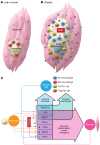Skeletal muscle inflammation and insulin resistance in obesity
- PMID: 28045398
- PMCID: PMC5199705
- DOI: 10.1172/JCI88880
Skeletal muscle inflammation and insulin resistance in obesity
Abstract
Obesity is associated with chronic inflammation, which contributes to insulin resistance and type 2 diabetes mellitus. Under normal conditions, skeletal muscle is responsible for the majority of insulin-stimulated whole-body glucose disposal; thus, dysregulation of skeletal muscle metabolism can strongly influence whole-body glucose homeostasis and insulin sensitivity. Increasing evidence suggests that inflammation occurs in skeletal muscle in obesity and is mainly manifested by increased immune cell infiltration and proinflammatory activation in intermyocellular and perimuscular adipose tissue. By secreting proinflammatory molecules, immune cells may induce myocyte inflammation, adversely regulate myocyte metabolism, and contribute to insulin resistance via paracrine effects. Increased influx of fatty acids and inflammatory molecules from other tissues, particularly visceral adipose tissue, can also induce muscle inflammation and negatively regulate myocyte metabolism, leading to insulin resistance.
Conflict of interest statement
C.M. Ballantyne is a consultant for AstraZeneca, Boehringer Ingelheim, Merck, and Sanofi-Synthelabo, and has a provisional patent (no. 61721475) entitled “Biomarkers to improve prediction of heart failure risk,” filed by Baylor College of Medicine and Roche.
Figures



References
-
- Poirier P, et al. Obesity and cardiovascular disease: pathophysiology, evaluation, and effect of weight loss: an update of the 1997 American Heart Association Scientific Statement on Obesity and Heart Disease from the Obesity Committee of the Council on Nutrition, Physical Activity, and Metabolism. Circulation. 2006;113(6):898–918. doi: 10.1161/CIRCULATIONAHA.106.171016. - DOI - PubMed
-
- Lackey DE, Olefsky JM. Regulation of metabolism by the innate immune system. Nat Rev Endocrinol. 2016;12(1):15–28. - PubMed
-
- Centers for Disease Control and Prevention. Diabetes Public Health Resource. CDC Web site. http://www.cdc.gov/diabetes/statistics/prev/national/figadults.htm Updated December 1, 2015. Accessed October 20, 2016.
Publication types
MeSH terms
Substances
Grants and funding
LinkOut - more resources
Full Text Sources
Other Literature Sources
Medical

